VIS 21B - Chinese Art
1/31
There's no tags or description
Looks like no tags are added yet.
Name | Mastery | Learn | Test | Matching | Spaced |
|---|
No study sessions yet.
32 Terms

Painted Bowl, Early Yangshao Culture
Subject: This is a painted bowl built from local materials.
Style: The bowl is painted with dark pigment and the images on the bowl are symmetrical. There’s a painted human face that has geometric and angular features. Fish bones decorate the bowl; bold thick lines. This was the typical style for these bowls.
Function: This bowl was used for meals. The designs show the lifestyle of the people at this time: People who lived by the Yellow River relied on fishing.
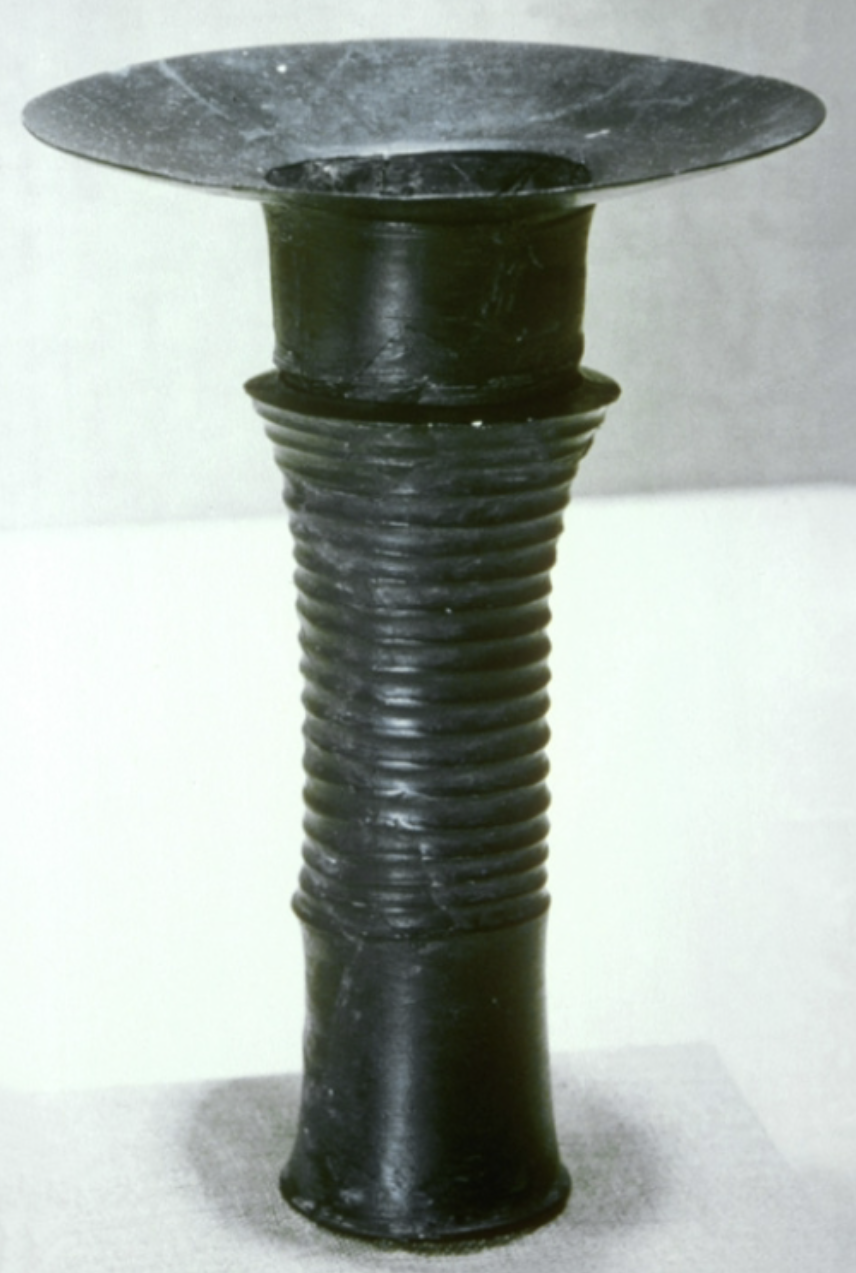
Gu Beaker, Longshan Culture
Subject: This is a three pronged wine vessel made of bronze.
Style: The vessel has a wide and round body, with a handle and thin legs. It also has a singular band of style 1 of Tao Tie that wraps around the vessel (simple lines raised from the body of the vessel). The Tao Tie is a decorative motif that features an image of a ogre that symbolizes gluttony.
Function: These wine vessels are used in rituals or ceremonies and not for everyday drinking or use.
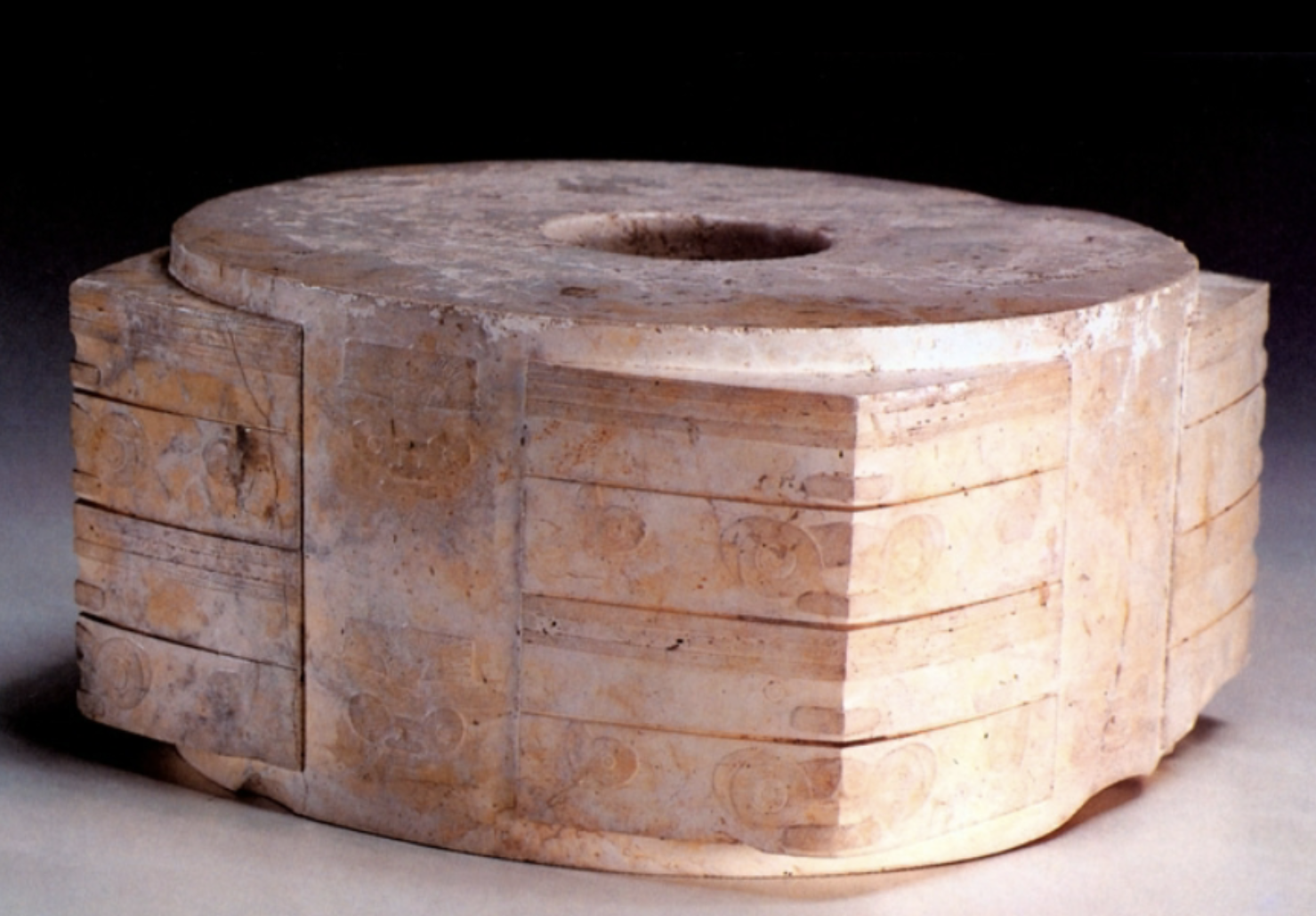
Prismatic Tube (Cong), Liangzhu Culture
Subject: This is a tube like structure called a cong made of nephrite jade.
Style: The cong has a relatively smooth and polished surface, expect for the cut in lines on the outside. The outside of the cong is square shaped; simple and flat. The inside of the cong is a tube. Some are tall and some are short. Some have low relief carving on the outside of water buffalo where the nose of the water buffalo protrudes from the four corners.
Function: The cong’s purpose is unknown, but we believe it is used for ceremonial or ritual purposes. The combination of round and square styles reflect ideas about the universe.
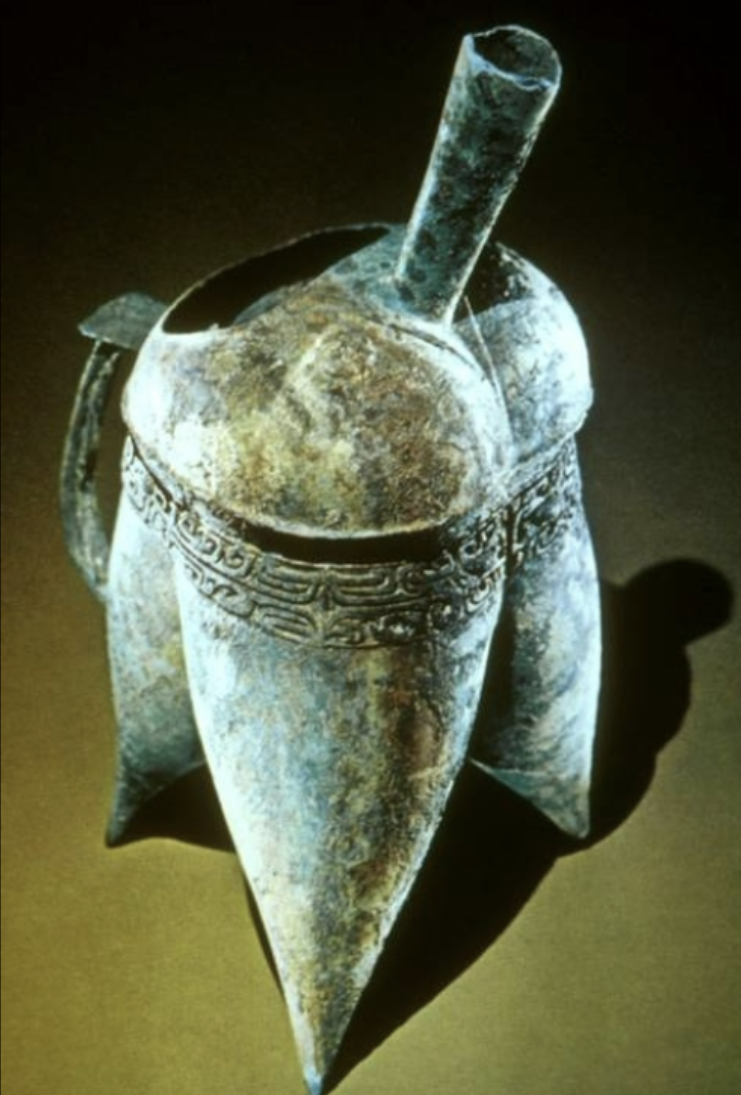
Li he, Ritual Wine Vessel, Early Shang Period
Subject: This is a ritual wine vessel made of bronze.
Style: The body of the wine vessel is wide and round with three pronged, thin legs with one handle for pouring wine. The body of the vessel had a singular band of style one Tao Tie that wraps around the vessel with simple lines raised form the body of the vessel. Tao Tie is a motif that features an monster or glutton mask that is formed with bold, thick, and continuous lines.
Function: The wine vessel is not used for everyday drinking, but rather for ritual or ceremonial drinking. The vessel was most likely made by the piece mold casting technique which shows the advancements of the Early Shang culture.
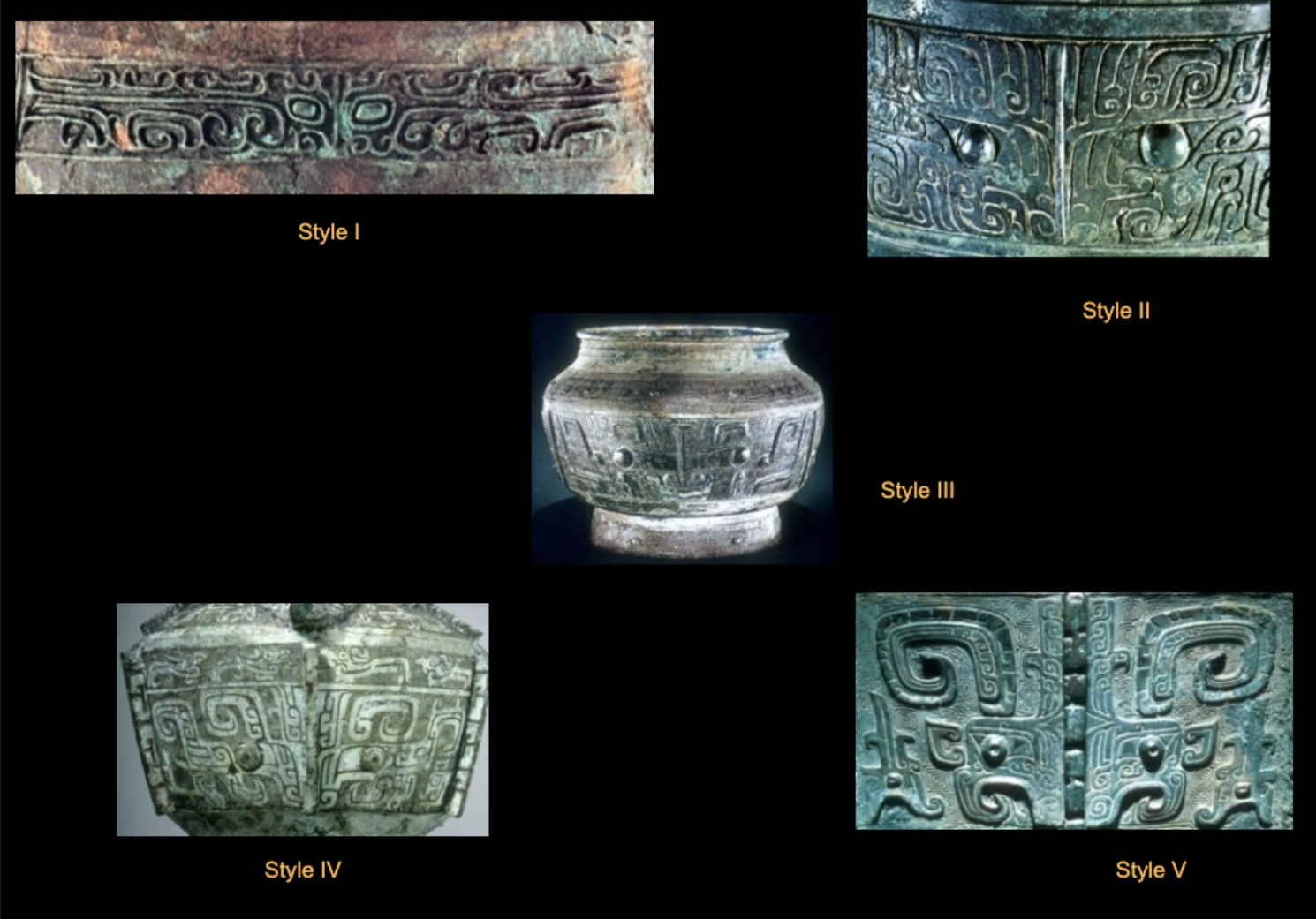
Max Loehr’s 5 Style of Shang Bronze
Style 1 → Singular band; raised lines
Style 2 → Singular band; cut in lines
Style 3 → Transitional period; two bands
Style 4 → Motifs cover entire surface; cut in lines
Style 5 → Tao Tie is low relief; water pattern is cut in lines as a background
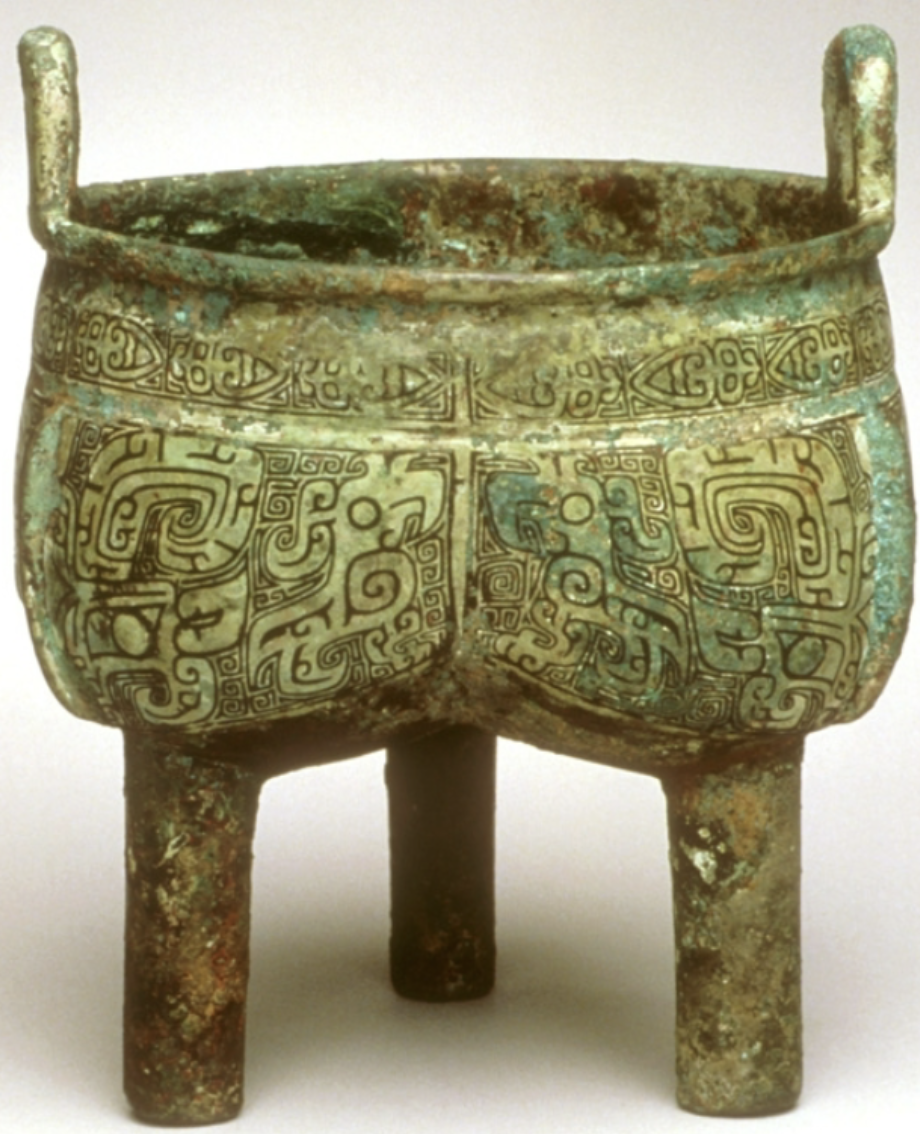
Ding, Ritual Food Vessel, Late Shang Period
Subject: This is a ritual food vessel called a Ding made of bronze.
Style: The vessel has a circular body, three legs, and 2 handles. This vessel has style 4 Tao Tie motif which covers the entire surface of the body with cut in lines (not raised). In addition to the Tao Tie motif, it has spiral patterns that are meant to represent water.
Function: These food vessel are also used in rituals or ceremonies and not for everyday eating or use.

Square Ding, Ritual Food Vessel, Late Shang Period
Subject: This is a square-shape Ding made of bronze with four legs.
Style: This square-shaped Ding has style five Tao Tie motif: Combination of low relief (raised) lines and cut in lines for the background (water/spiral pattern). Style five Tao Tie covers the entire surface of the vessel. This vessel also has the characters “Fu Hao” which might refer to the words female and good. This is an example of people claiming ownership of their property.
Function: This vessel was found at the tomb of Fu Hao so we can assume this vessel was used in a funeral. This culture believed that when royalty died they should have elements of life buried with them for the afterlife.
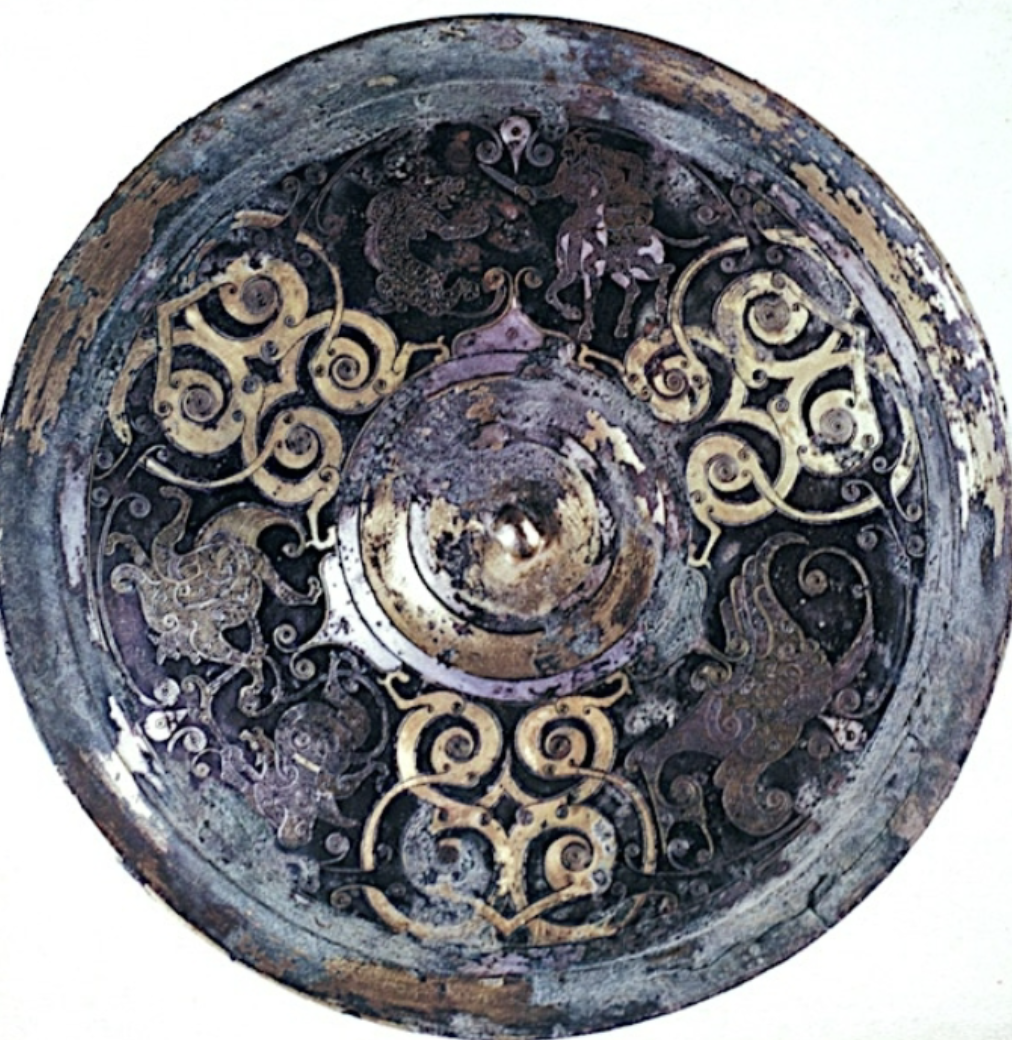
Mirror, Eastern Zhou Period
Subject: This is a circular mirror inlaid with gold and silver.
Style: The mirror has radial balance (symmetric). It also has interlocking abstract and geometric patterns that are meant to represent the wave or spiral pattern. It also has an image of a person riding a horse and fighting a beast.
Function: These mirrors could be used for grooming or they were used a burial items in tombs to reflect light and protect the deceased.
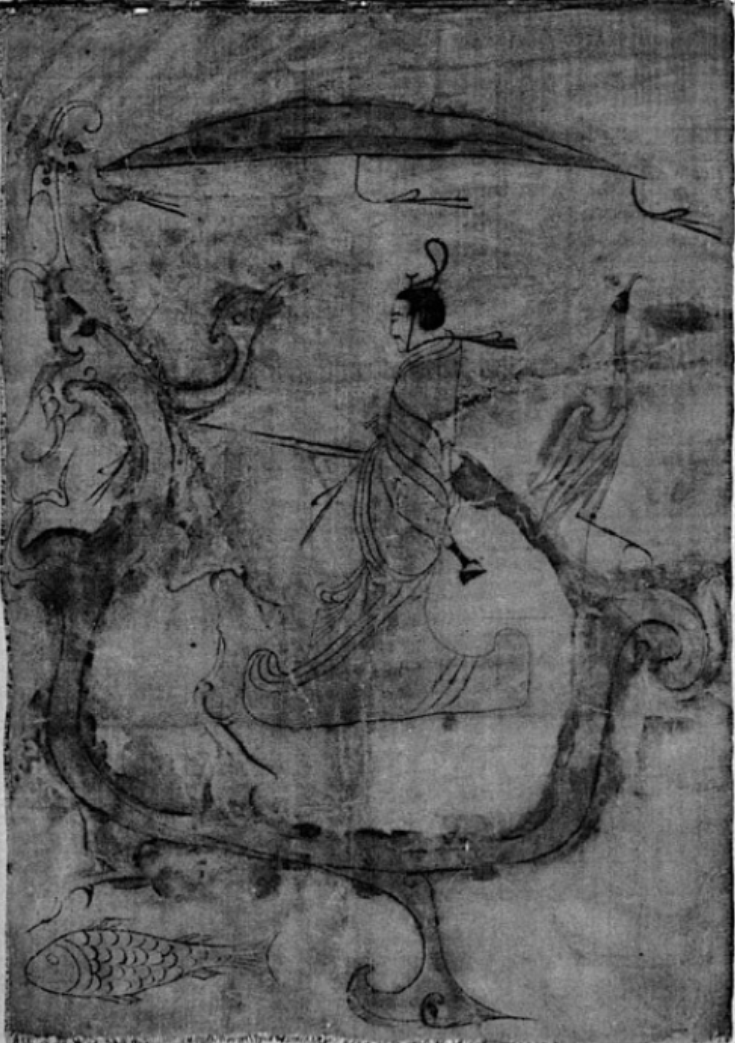
Man Riding Dragon, Eastern Zhou Period
Subject: This is a painting, in ink, on silk.
Style: It shows an image of a man riding a dragon or dragon chariot; it is outlined or in the linear style. There is also an image of a phoenix; the dragon and phoenix are often shown together because the represents the king and queen or royal families in general.
Function: Silk was a very important textile and was often found in coffins and tombs. These silk paintings usually symbolized high status or court memebers.
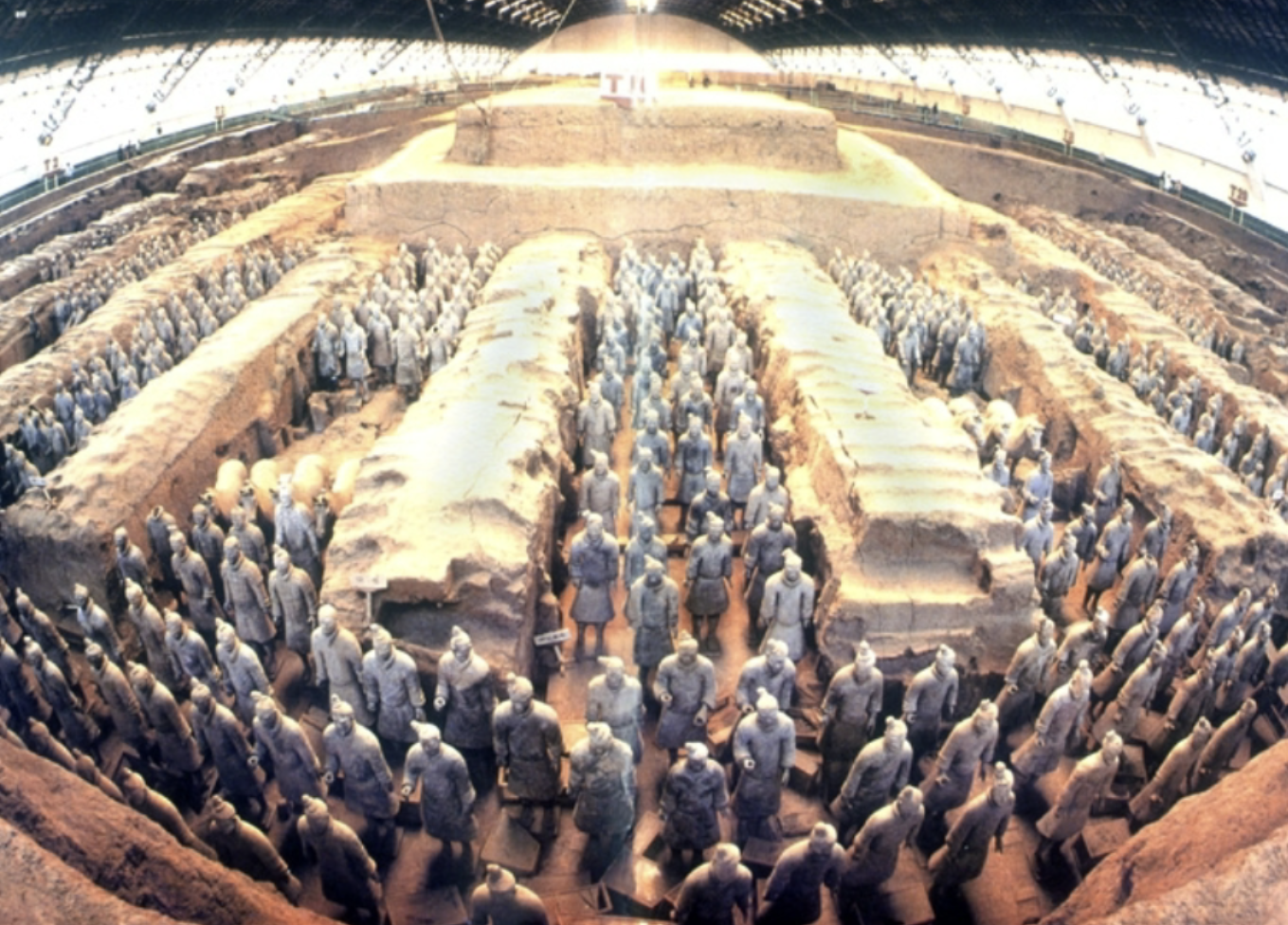
Tomb Pit, Qin Dynasty
Subject: This is a massive tomb pit with an Earthenware burial army.
Style: There are many rows of terracotta soldiers (life size) in various standing postures. They are very life-like, with realistic facial features and proportional body parts (very detailed faces that are similar to the local population). There are 200 different types/styles that indicate different groups of people that individualized based on class.
Function: The purpose of the burial army is that they were supposed to protect the Emperor of Qin in the afterlife. The body parts are made separately and were put together on site.
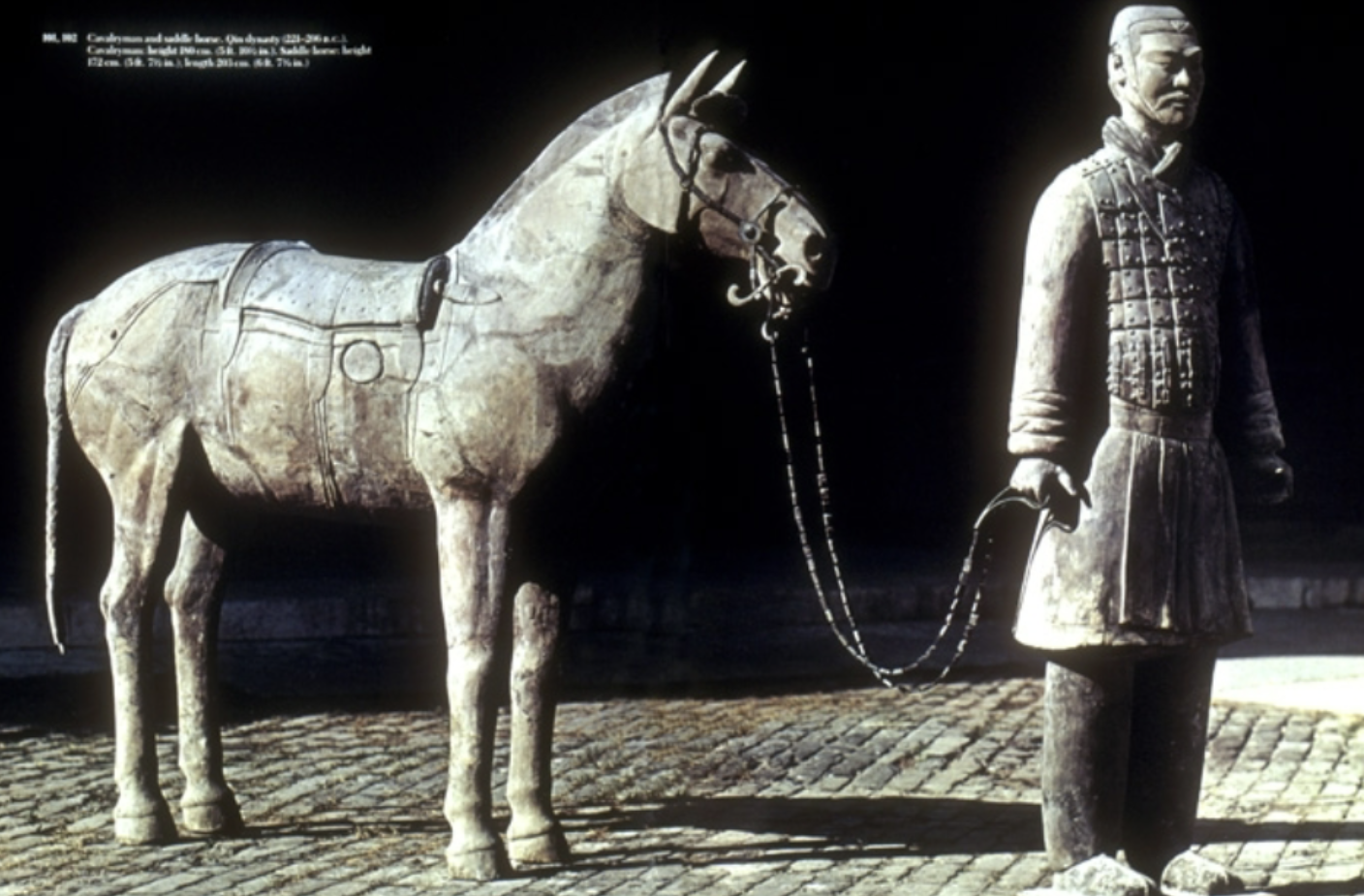
Cavalryman and Saddled Horse, Tomb Pit, Qin Dynasty
Subject: This is a 3D terracotta sculpture of a man with a horse that is part of the burial army.
Style: The man and horse are very realistic and lifelike. But the sizing and proportions of the horse in relation to the man are off or wrong. The horse is far too small compared to the man, however, the horse is still very realistic. The man’s facial features are inspired by the local people and his style is defined by his class.
Function: The purpose of the burial army is that they were supposed to protect the Emperor of Qin in the afterlife. The body parts are made separately and were put together on site.
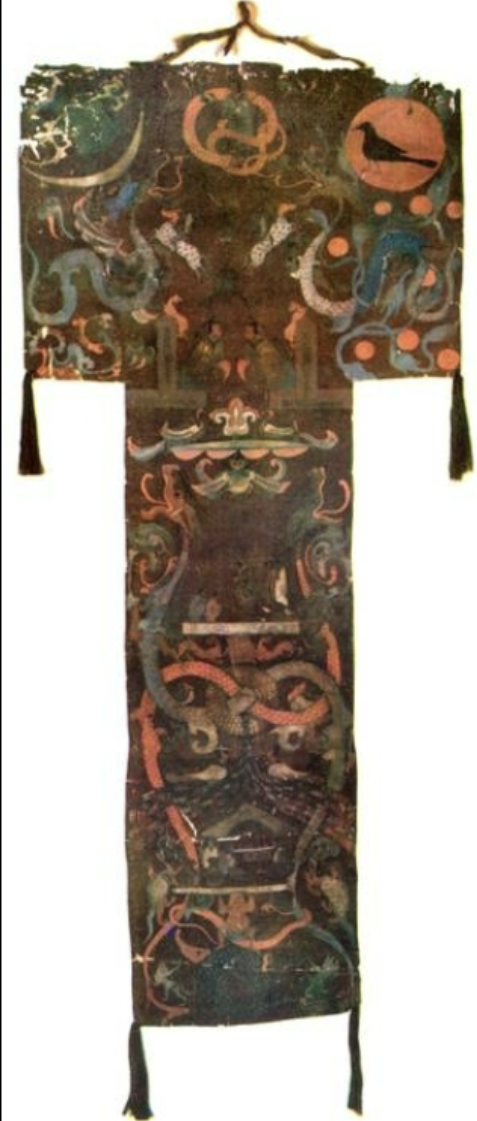
Flying Banner, Tomb of Marquis of Dai, Han Dynasty
Subject: This is a silk banner painted with ink that is T-shaped.
Style: The banner reflects ideas about the afterlife and the universe; shows images of the three worlds which are heaven, our world, and hell. For example, the Queen Mother of the West is in the center of the composition, surrounded by symmetrical dragons. In addition to this, the wife of Li Cang, drawn in profile, is colorful and heavily decorated (visual hierarchy cause she is the biggest image in the composition). Hell is shown to be underwater with interlocking images of fish, serpents, and turtles.
Function: This banner is used in the funeral procession; leading the procession. When they placed the coffin in the ground, they would place the banner on top of the coffin and cover it with a second coffin.
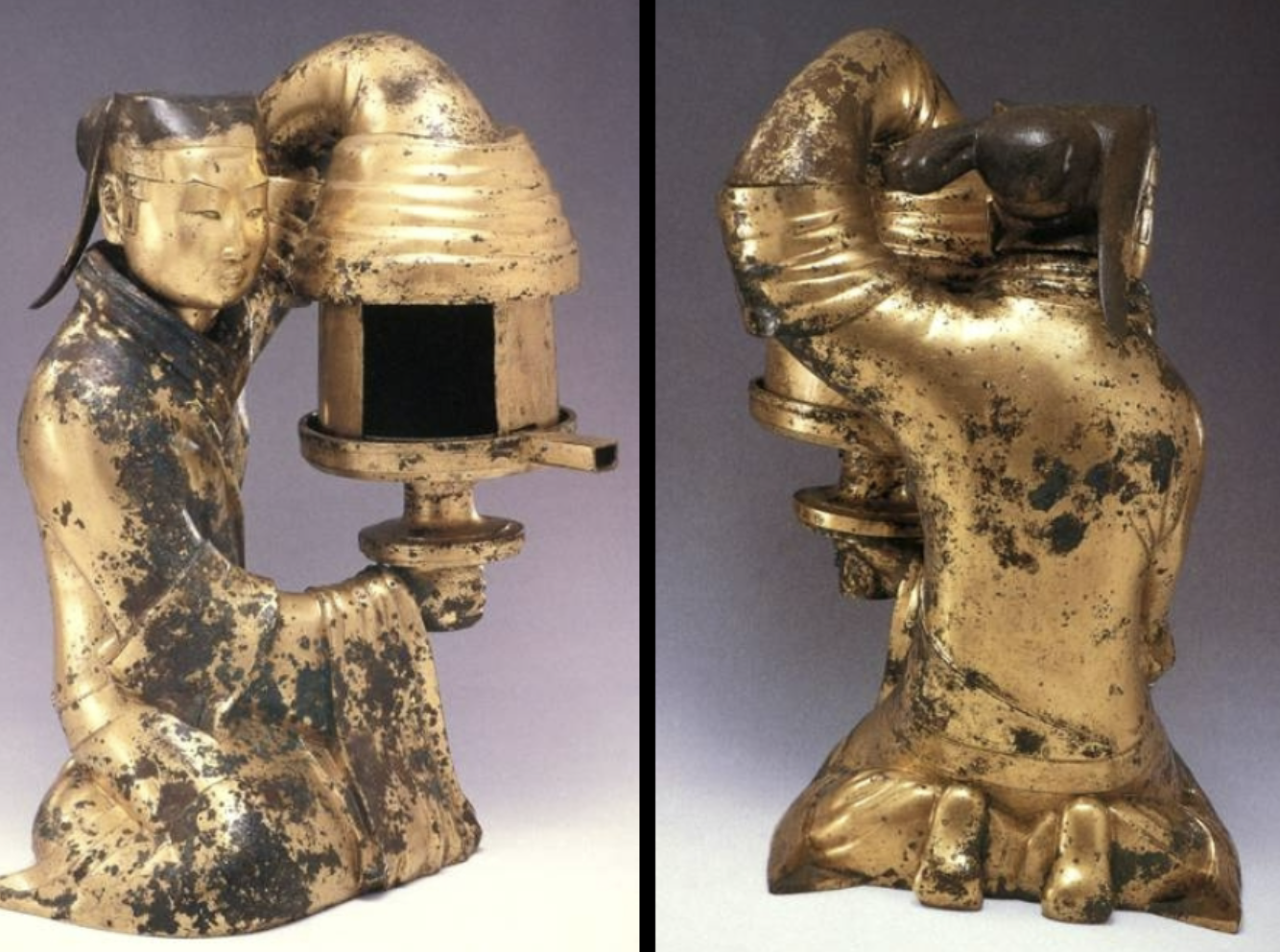
Lamp, Tomb of Dou Wan, Han Dynasty
Subject: This is a lamp that is in the shape of a servant girl; gilt bronze.
Style: This is a free standing sculpture. The girl is very naturalistic, with realistic facial features that was most likely inspired by the terracotta burial army. Interesting enough, because her feet are depicted (kneeling posture) you are able to view the sculpture from all sides.
Function: The lamp was made to be functional and pleasing to the eye, showing the high status of Dou Wan. Shows the skill craftsmanship and innovative design of the Han Dynasty (the servant girl’s sleeve functions as part of the lamp).

Gentlemen in Conversation, Tomb Tile, Han Dynasty
Subject: This is a painted Earthenware tomb tile of gentlemen in conversation.
Style: The tile is painted with a horizontal composition with no visual hierarchy. The men are drawn with a 3-quarter face which shows an understanding of facial features (more realistic and mature style). The figures and their clothes are drawn with iron wire strokes (long, thin lines that create elegant drapery).
Function: This is a good example of the new Chinese style of painting that not only shows a relationship between figures in the composition, but also relationship between figures and viewers because it shows normal people.
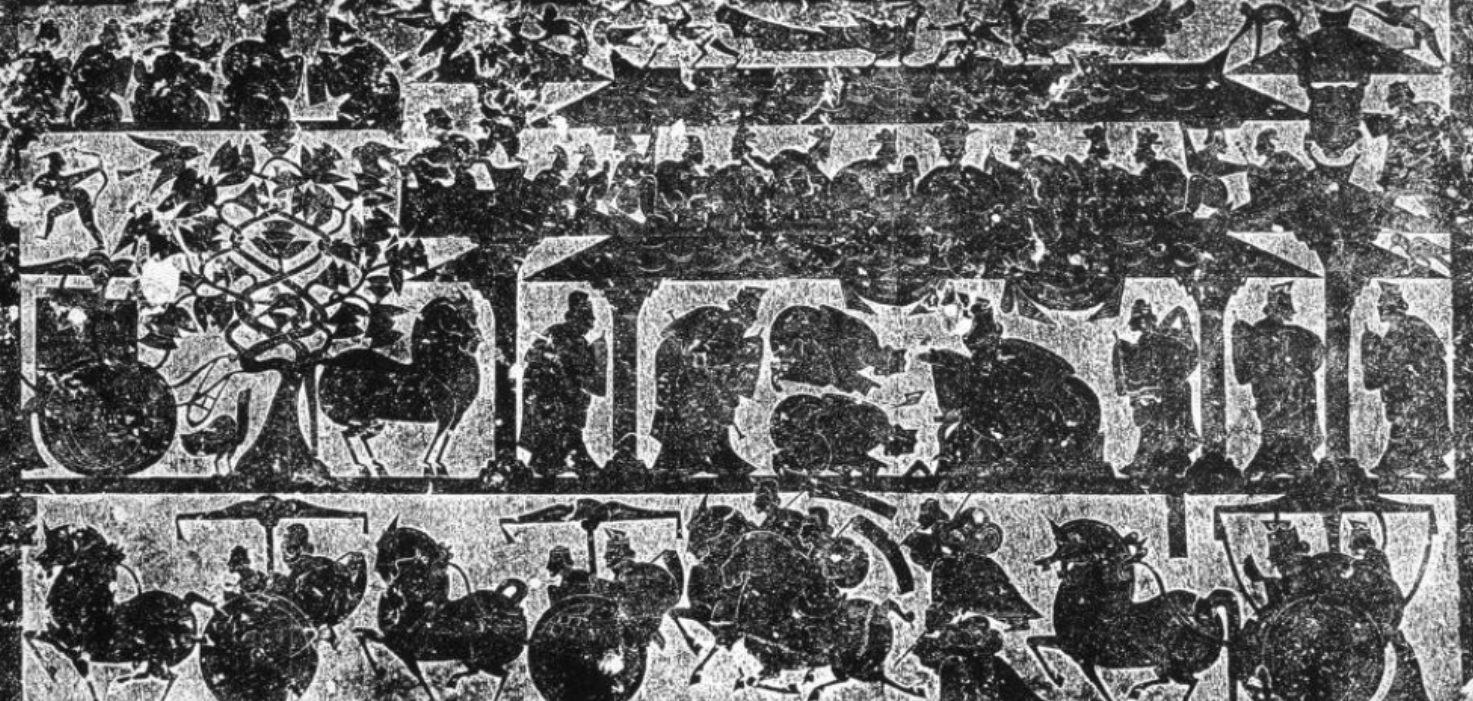
The Archer Yi, The Fushan Tree and Reception in a Mansion, Wu Family Shrine, Han Dynasty
Subject: This is a rubbing of a stone low-relief carving that shows various scenes of life.
Style: The composition in spilt into the horizontal sections that shows figures in profile. One of the scenes shows students meeting with Confucius, kneeling before him. The Queen Mother of the West is also depicted. The composition is very flat, with not a lot of depth.
Function: These Earthenware tile were used to decorate tombs. They are funerary objects that showed scenes of everyday life and hierarchies that were thought to accompany the deceased into the afterlife.
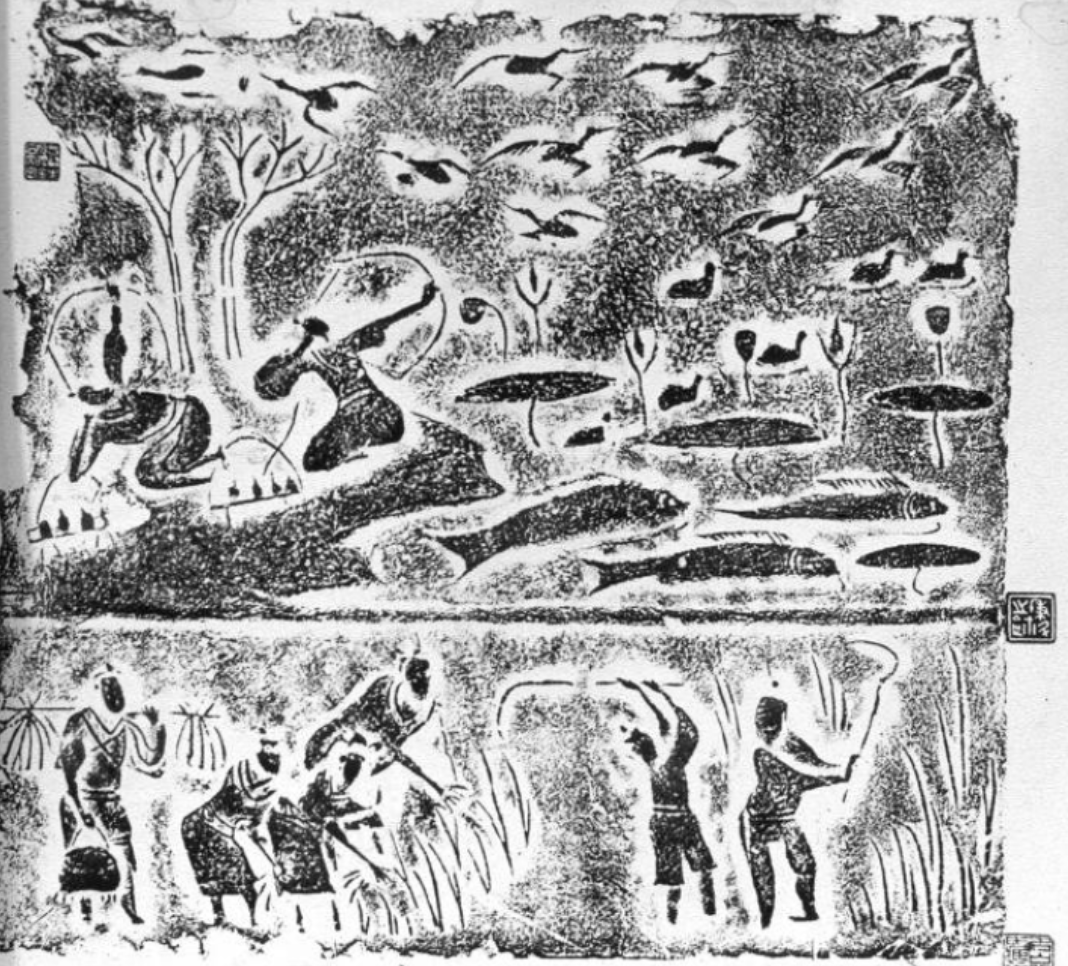
Scenes of Hunting/Harvesting, Rubbing of Earthenware Tile, Han Dynasty
Subject: This is a rubbing of a stone low-relief carving that shows various scenes of hunting and harvesting.
Style: The composition is split into two horizontal sections; the top scene shows hunters shooting birds and the bottom scene shows people harvesting in the field. Both compositions use diagonal lines that create a sense of depth. For example, the birds and fish move toward the back of the composition. The figures are overlap each other, this is known as perspective.
Function: Both sections show everyday life of the common people.
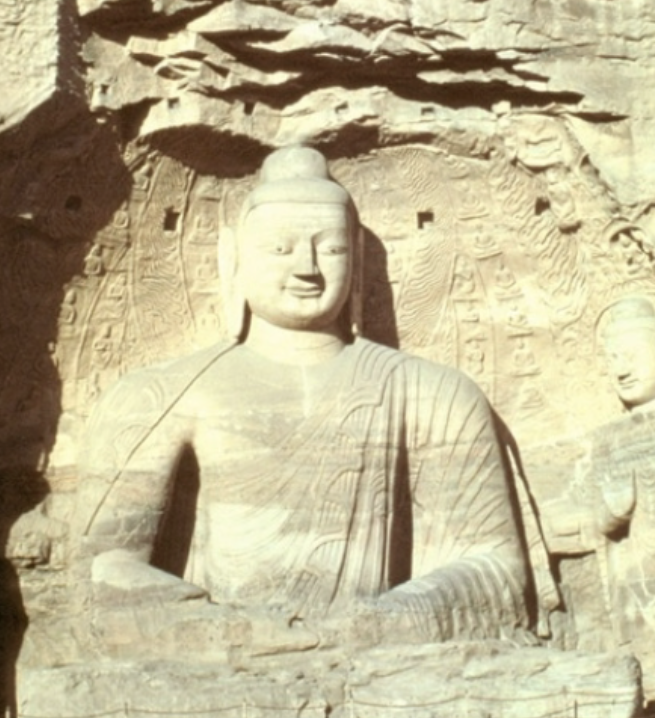
Colossal Buddha, Yungang Caves, Wei Dynasty
Subject: This is an example of rock-cut architecture of a giant Buddha statue cut into the side of the mountain.
Style: We can clearly see the influence of the Gupta style: Downcast eyes, elongated ears, and wrinkles on the neck. There is a very noticeable visual hierarchy where the giant Buddha is seated in the middle of the composition. Behind the Buddha is a very detailed, low relief halo with smaller seated Buddhas.
Function: These caves are a great example of Chinese Buddhist architecture and art.
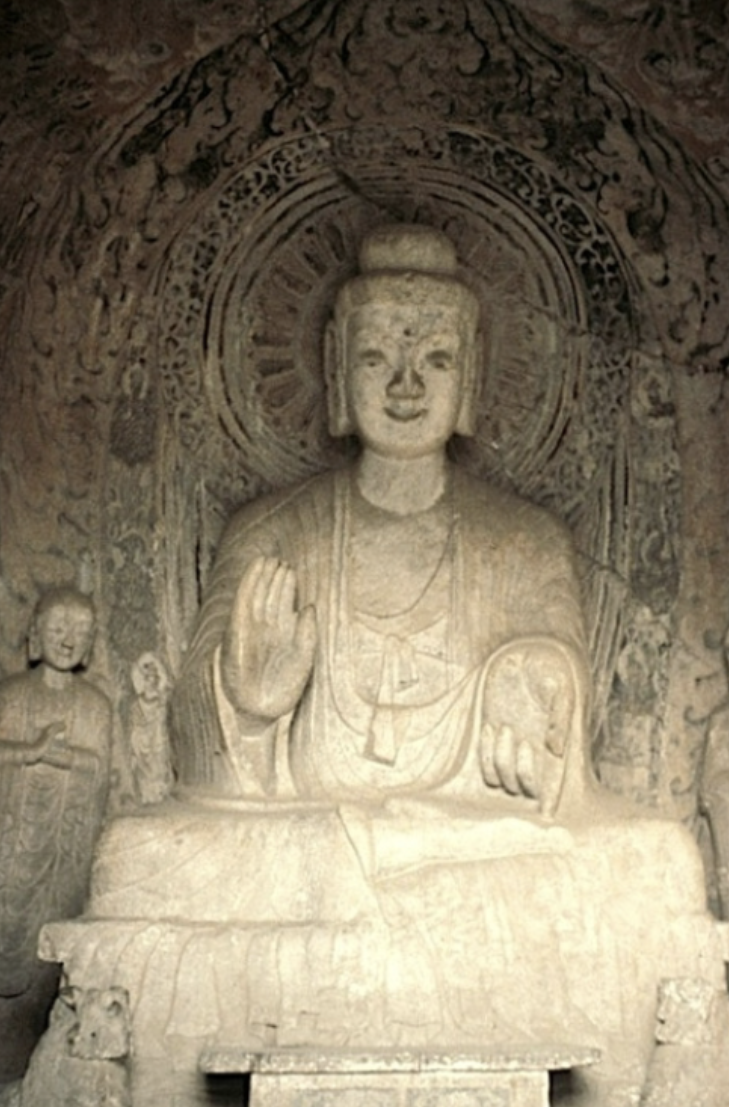
Seated Buddha (with attendants), Longman Caves, Wei Dynasty
Subject: This is a rock-cut statue of the Buddha in a seated position.
Style: There is a visual hierarchy, where the Buddha is the largest and seated in the center of the composition and is flanked by two Bodhisattvas and two Chinese monks. There is the basic iconography of the Buddha: Hair style, elongated ears, and hand gesture. But we see different facial features (long rectangular face, wide open eyes, and the nose and mouth are inspired by the local Chinese people’s features).
Function: What’s interesting about this Chinese Buddhist art is the inclusion of the two Chinese monks that were responsible for helping to bring Buddhism to China.
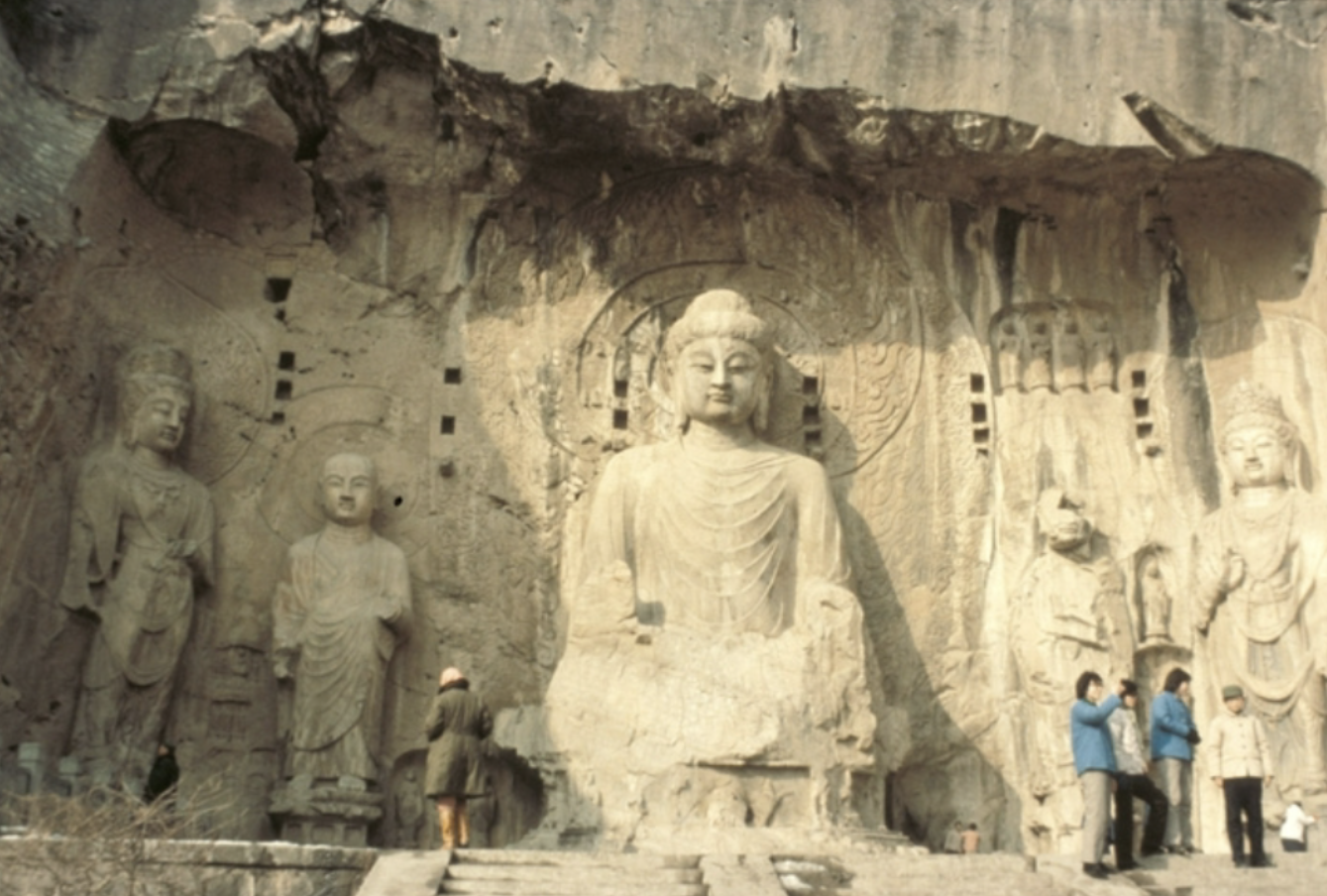
Buddha Vairocana with Attendants, Longman Caves, Tang Dynasty
Subject: This is a rock cut cave or temple with a giant rock cut statue of the Buddha.
Style: The major image, the rock cut statue of the Buddha, is in the center of the composition (visual hierarchy). The giant Buddha is flanked by two Bodhisattvas and two Chinese monks. The Vairocana Buddha is usually shown with a chubby face, smiling appearance, and wide shoulders. The Buddha has very realistic facial features and the typical iconography of the Buddha (three wrinkles on the neck, hair style, and elongated ears). There are also high relief sculptures of the secular guardian kings with fierce facial features that are meant to scare demons away.
Function: The Vairocana Buddha is the original Buddha that controls all the reincarnation of the original Buddha.
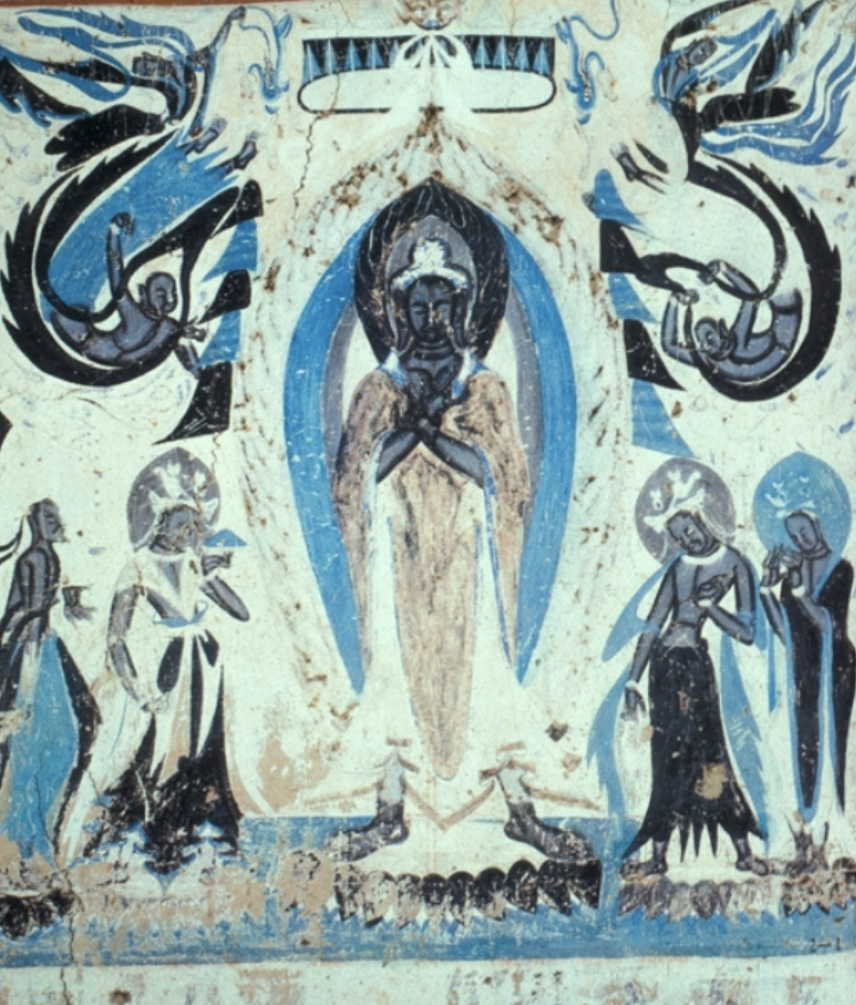
Preaching Buddha, Wall Painting, Magao Caves, Wei Dynasty
Subject: This is a wall painting at a large rock cut Buddhist cave.
Style: We see a visual hierarchy where the Buddha is at the center of the composition and is the largest, most prominent figure. Flanking the Buddha, are two Bodhisattvas that have S shaped which parallel each other; influenced by Central Asian countries. The Buddha is in a standing posture with a non circular halo behind him (Central Asian countries). The figures are painted with organic shapes and fluid/flowing lines.
Function: The Mogao Caves were a place of Buddhist scholarship. Interesting enough, the Buddha at the center of the composition reflects ideas about the universe.
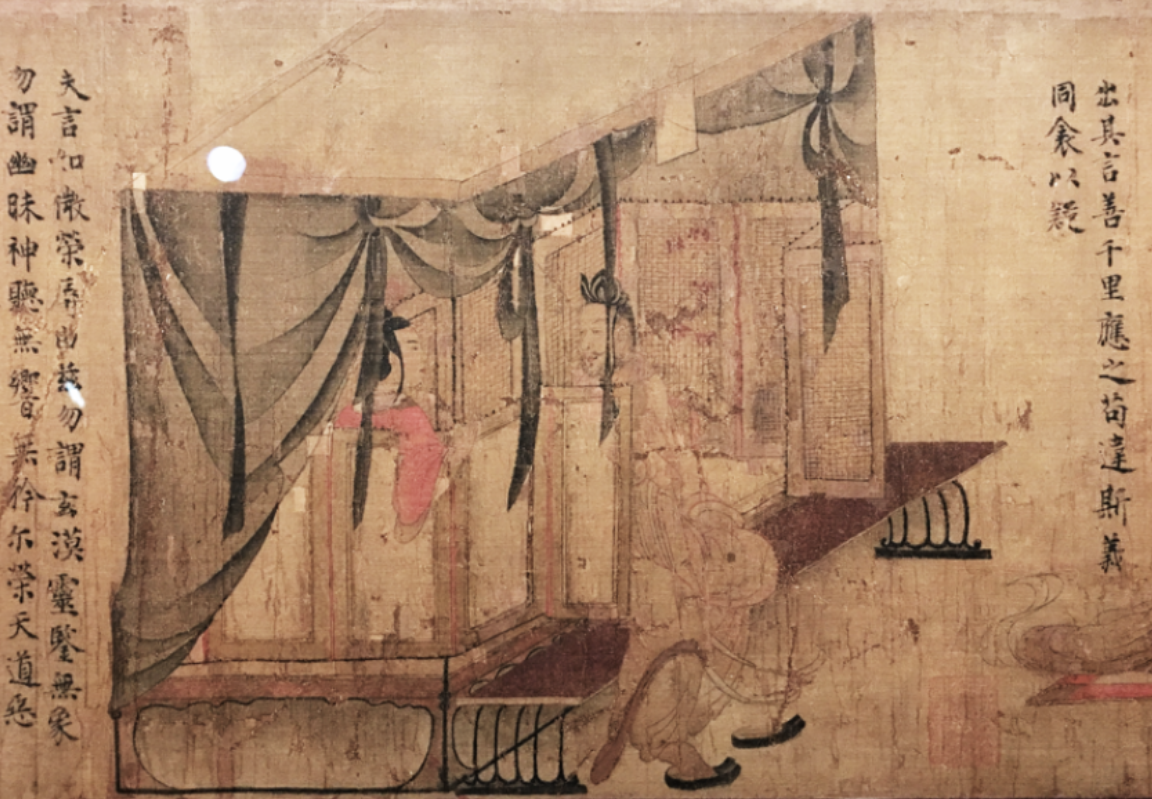
Admonition of the Court Ladies, 6 Dynasties Period
Subject: This is a hand scroll that was painted using ink onto silk.
Style: The hand scroll is split into different horizontal sections that show various scenes of court ladies. The court ladies are painted in the elongated style: Fine, curved, and continuous lines which created an elegant body shape (iron wire stroke). There are no background, but there is implied depth: Reverse perspective, where the vanishing point is in the front and not back of the composition (Chinese perspective).
Function: This hand scroll was made based on Confucius moral standards and teachingThe scroll was meant to educate the palace ladies on their behavior and what they should do in certain situations.
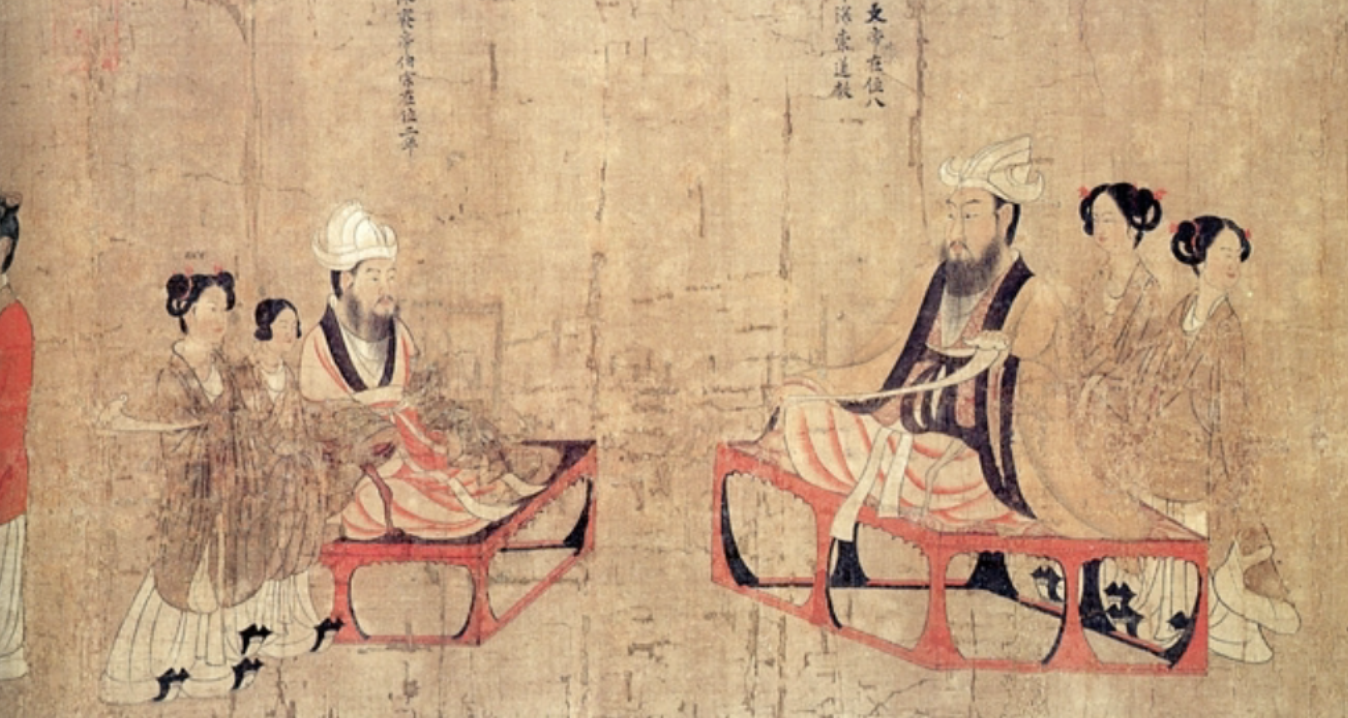
Scroll of 13 Emperors, Tang Dynasty
Subject: This scroll was painted by court painter Yan Liben, which gives insight into the Tang Dynasty style of painting and what the Emperors wanted their court painters to focus on.
Style: The scroll has the portraits (individualized facial features) of the 13 Tang Emperors. The figures are painted with great skill and fine lines; calligraphic influence and iron wire stokes to create these elegant figures. Yan Liben also used the typical abstract background and reverse perspective.
Function: The purpose of this scroll is didactic or educational which communicates the idea that these Emperors were paragons of moral and political virtue in relation to Confucianism and Daoism.
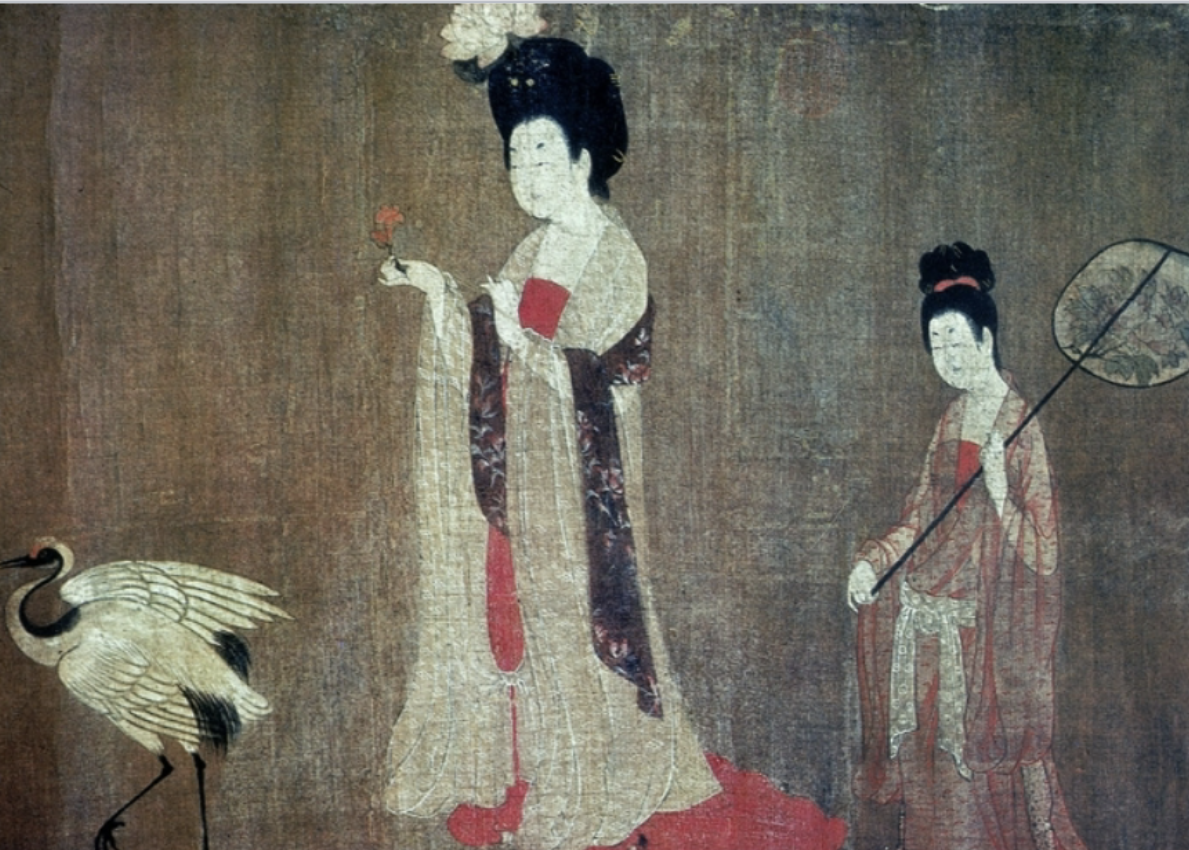
Ladies with Flowers in their Hair, Tang Dynasty
Subject:
Style:
Function:
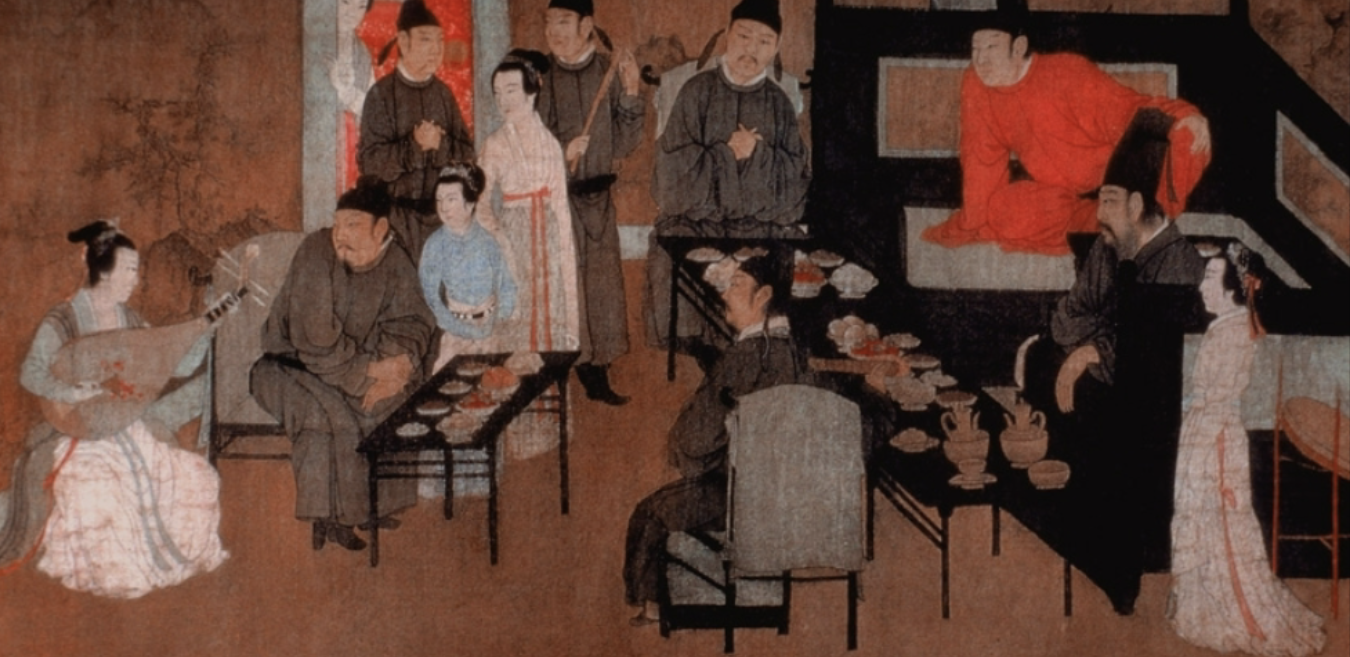
The Night Revels of Han Xizai, 5 Dynasties
Subject: d
Style:
Function:

A Solitary Temple Amid Clearing Peaks, 10th C.
Subject:
Style:
Function:

Traveling Amid Mountains and Gorge, Hanging Scroll. 10th-11th C.
Subject: This is a landscape done on a hanging scroll using ink on silk.
Style: This is a full scene landscape that is divided into three grounds: Foreground, middleground, and background. These grounds are divided by fog and mist creating a deep sense of depth and space (shift perspective). The mountains are done with raindrop textured strokes that create a rough and rocky mountain surface. These were created with short paint strokes. The full scene landscape is very proportional and realistic.
Function: Showcases the Northern Song Dynasties advancements with paintings: Full scene landscape with three grounds and raindrop textured stroke. Hanging scrolls were used to display paintings and calligraphy.

Early Spring, Hanging Scroll, Song Dynasty
Subject: This is a landscape painting of trees and mountains in the early spring.
Style: This landscape painting has a masterful and mature sense of depth and space due to what is called atmospheric perspective. This is when the artist uses different tones of link to create a contrast between light and dark. The background is pushed back due to lighter tones while the foreground is pulled forward due to darker tones (fog and mist also divide the composition into different grounds). The trees are painted with crab claw stroke that created texture, while the mountains are done with ink wash for less texture.
Function: This landscape showcases the Northern Song Dynasties advancements with paintings: atmospheric perspective and crab claw textured strokes. Hanging scrolls were used to display paintings and calligraphy.

Parakeet on Apricot Tree, Song Dynasty
Subject: This a painting done with ink on silk of a parakeet perched on the branch of a apricot tree.
Style: The parakeet and apricot branches and blossoms are done with great detail and are very realistic in style and proprpotlions. The background is empty but makes the detail of the parakeet and tree stand out against the plain background. There is also what is called slender gold style calligraphy and seals off to the side.
Function: This painting is an example of the realistic court painting style that Emperor Huizong mastered (this emperor poured a lot of resources into the Imperial Painting Academy to help raise the status of court painters) The Imperial Painting Academy was used to educate and train people for court painting (had to pass exams).
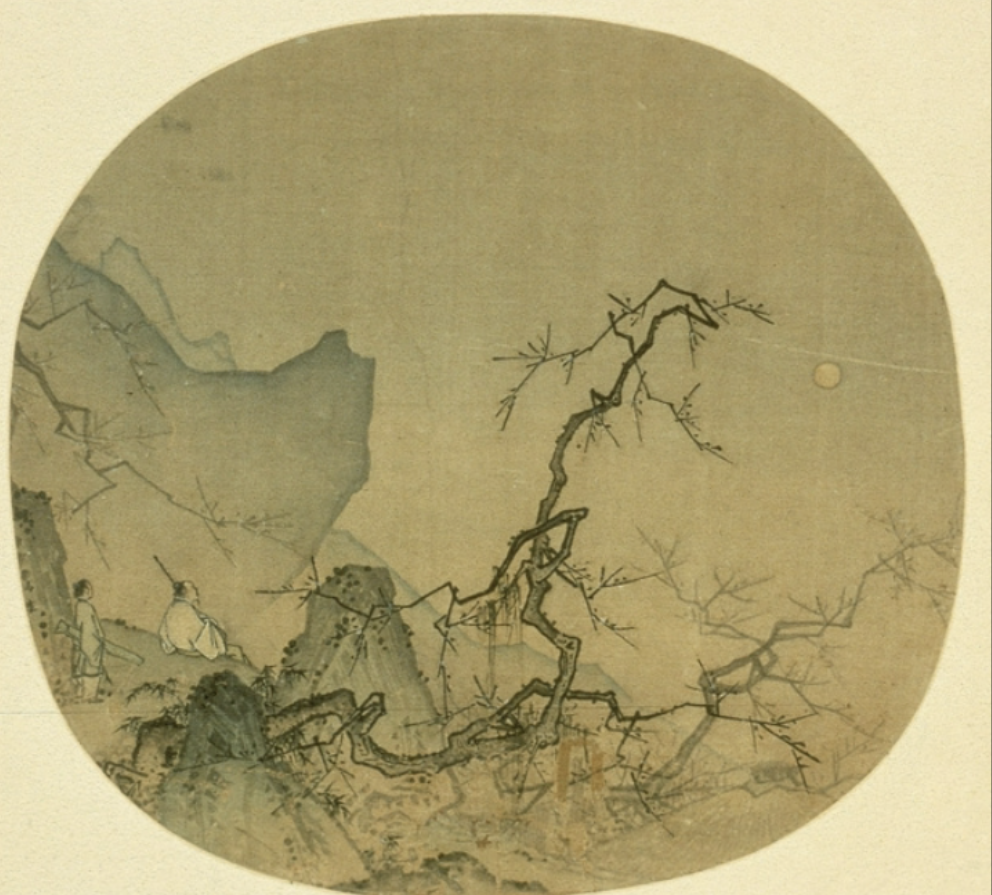
Viewing Plum Blossoms by Moonlight, Song Dynasty
Subject: This a Southern Song landscape that is in the round fan format.
Style: The Southern Song landscapes usually have only two grounds that communicate depth: Foreground and background. The foreground usually has the most texture and imagery while the background is done with ink wash and no textured strokes. The Southern Song landscapes are also done in the one corner style where the composition takes place in the corner (the foreground and background are on one side of the composition). The rest of the composition is empty space (leaves room for the imagination). The iconography of this landscape includes trees, mountains, and figures (the trees are done with axe-cut strokes, the mountains are done with ink wash, and the figures are done with nail head rat-tail strokes). These strokes are very angular and can communicate different seasons (winter or early spring).
Function: Showcases the one corner composition of the Southern Song landscapes and round fan format which provided close up or intimate views of the composition (contrast with the monumental landscapes of the Northern Song Dynasty).
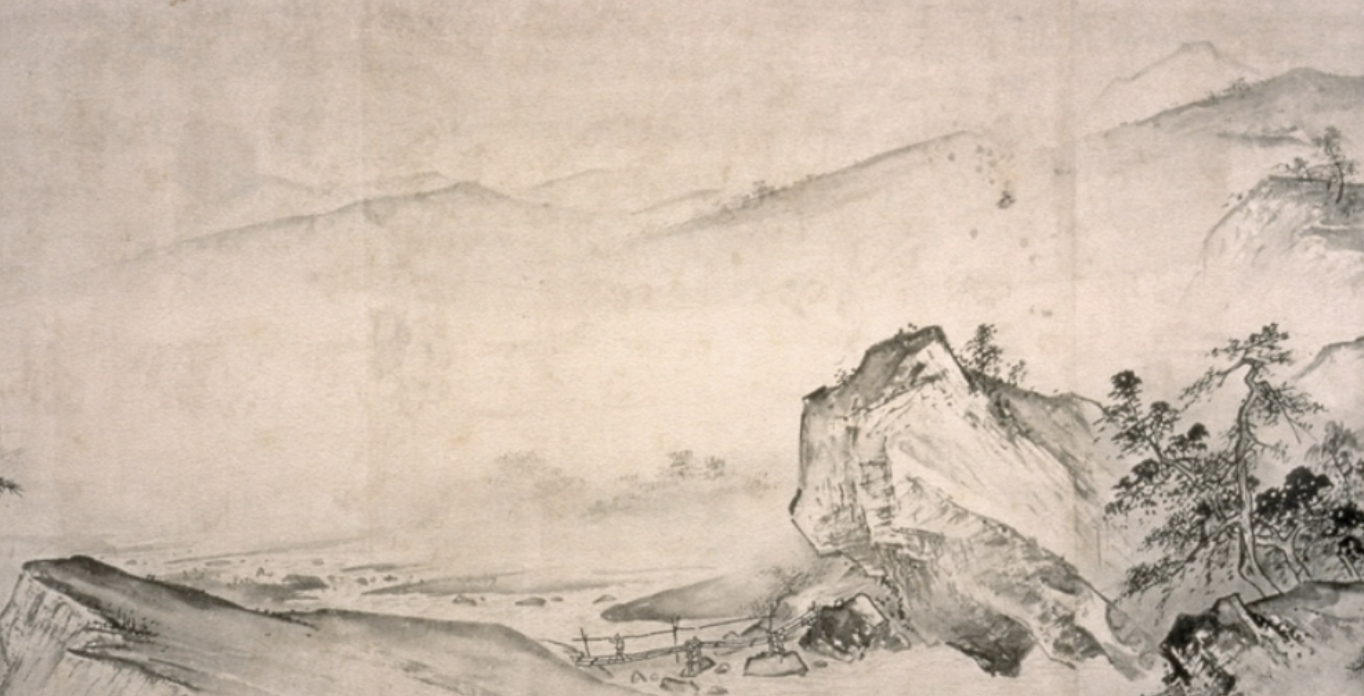
View Over Rivers and Mountains, Song Dynasty
Subject: This is a hand scroll done with ink on paper of a landscape.
Style: The landscape is in the one corner style, with a horizontal composition. There is a sense of depth due to the foreground and background being separated by mist or fog. Typical of one corner style, there is a large empty space in the background. This empty space is left for viewers to fill with their imagination. This landscape was also done with ink wash; you are able to see the different tones of ink that create smooth transition between grounds (atmospheric perspective).
Function: The artist, Xia Gui, was known as “half sided Xia” for the empty space they would leave in the background. Hand scrolls allowed for a continuous narrative visual journey.

Chan Patriarch Chopping Bamboo, Song Dynasty
Subject: This is a hanging scroll done with ink on paper of a Chan Patriarch.
Style: It’s in the style of one corner composition with the typical empty background that was left empty for viewers to fill with their imagination. Most of the elements reside in the foreground of the composition including the human figure (which contrasts with iron wire strokes because these strokes are dagger like and jagged), with an implied sene of space with the mountain in the background. The artist used quick brush movements to create a lot of texture (nail head rat-tail strokes). The story behind the iconography is that the Chan Patriarch received enlightenment while chopping bamboo.
Function: This scroll deals with religious themes of Chan Buddhism (sudden enlightenment, spontaneity, simplicity, and purity) and combines their concepts with secular painting style (brush strokes). Sometimes enlightenment doesn’t come from meditation, but action. Hand scrolls allowed for a continuous narrative visual journey.

Autumn Colors on Qiao and Hua Mountains, Yuan Dynasty
Subject: This is a hand scroll with ink and color on paper of a landscape.
Style: The landscape has a long horizontal composition, with trees in the foreground and a mountain in the background. There is a sense of depth and space due to the separation of foreground and background, where everything moves back into space (the proportions are a bit off). The trees are not drawn with angular lines but with organic lines and the mountains are very textured compared to the Southern Song Dynasty. The painting also has various inscriptions and seals.
Function: This painting was commissioned and drawn by the court painter Zhao Mengfu who made a point to distance the Yuan style of drawing from the Southern Song Dynasty style. Hand scrolls allowed for a continuous narrative visual journey.